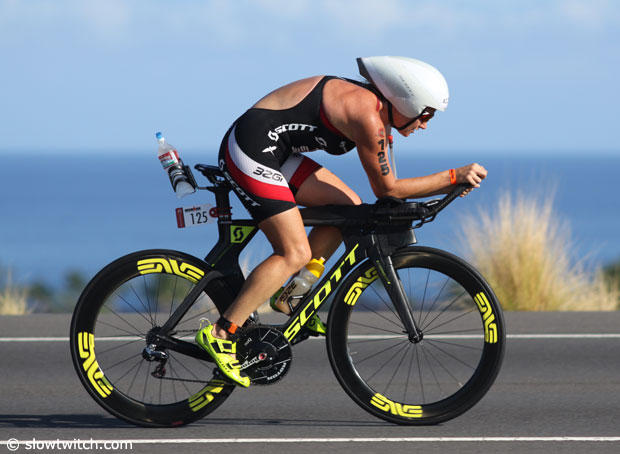Many go to Kona hoping for a win, and they're not all athletes. Who came out of Kona smiling?
When I began the Kona Bike Count in 1992 there were over 200 bike brands represented in the race. There has been some consolidation at the top, because the barrier to entry is high. Used to be that an old mechanical Bridgeport mill, a gas torch and a headbadge was all you needed to be a bike maker. Not so now, when the great majority of new bikes pop out of molds, and a size run of molds costs tens of thousands.
But there is still a shipload of bike brands on that pier. Who won?
Five or six companies stand out in my mind. First, of course, Cervelo, with 496 bikes in the race – almost 1 in 4 – and it wasn't that long ago that Cervelo was thought by many retail stores washed up, the brand of the past. Obviously rumors of its demise were greatly exaggerated. In my opinion, one stat that holds up fairly well is:
incremental gains = (this year's total) - .75(last year's total)
The idea is to guess at incremental gains year-over-year. If Cervelo, the company, was wiped off the map, you'd still see a lot of bikes the subsequent year. How many? Historically, 75% of the prior year's total is not a bad number.

So, if last year Cervelo had 485 bikes in the race, and if sold no new bikes since last year, that means with attrition it might have returned 364 bikes to Kona this year (using this admittedly crude equation). The incremental rise, then, year-over-year, was 132 bikes according to this calculation, that is to say, Cervelo "sold" 132 of the bikes in this year's race over the past year. That's a hefty number. Trek did very well according to this formula, with an incremental bike gain of 95 bikes. Specialized would be at 85.
Among perennial Ironman brands one loser using this calculation would be Cannondale, having sold, in the past year, only 13 bikes to those competing in this year's Kona race. Cannondale used to be a powerhouse in tri. What happened? It's last intro, the Slice RS, was a flop. But Cannondale has two things that bode well for the future: a new Slice that's quite good, and a set of retailers that understand this business. Look for Cannondale to rebound.
If you look past the pier count and out onto the course, there were three winners at this year's Ironman, it seemed to me. Felt has to be happy with its 1-2 finish in the women's race. The overall win is very nice but, as a former bike manufacturer myself, I always preferred to have the hammer on the bike aboard my product. Felt had both, with Rinny taking the win, and Daniela Ryf (pictured above) out there thrashing everyone on the bike course.

Best is when you can get both the overall winner and the bike course hammer in the same person. Scott not only had the race's overall winner, but he was a winner off a fast bike ride. That's unusual in the men's race – over the course of the last 25 years typically it's the fastest run that wins. When the winner does it on the bike that bodes well for the bike company, if that company is prepared to exploit the win. Kuota is a historic case in point, off of Normann Stadler's 2004 and 2006 wins.
Scott not only had Kienle out there, the one female athlete who might have surpassed expectations and gained admirers was former short courser Jodie Swallow (pictured just above). The 4th place finisher on the day led out of the water and was an early stalwart on the bike.

As kind as Kona was for the brands mentioned above, maybe the single biggest lift any one brand got was Dimond. If beam bikes make a comeback, this might be the one. Two weeks before Ironman we polled Slowtwitchers, and 60 percent of them were favorable to the idea of a beam bike. Dimond was the clear winner, getting about 3 times the votes of the second most popular beam bike among Slowtwitchers, Falco.
At Kona, there were 21 of these bikes popularized by TJ Tollakson, and for a new company with very little money behind it that was a tall number.
Then, big Maik Twelsiek (above and below), largely forgotten the past 3 years, newly aboard a Dimond, charged to the front of the ride in Kona and traded the lead with eventual winner Sebastian Kienle in the later stages. Maik's 4:24:03 was the second fastest of the day and he came in a creditable 11th overall.



